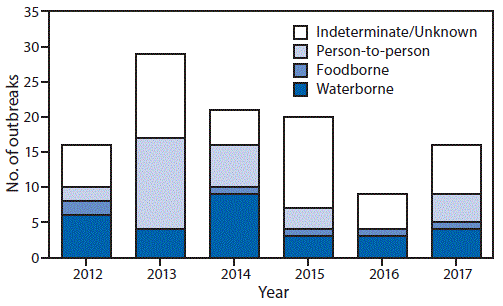That’s what we call it in Ontario. Beaver poop in water consumed by thirsty hikers
Great source of Giardi. The Centers for Disease Control writes:
What is already known about this topic?
Giardiasis is a diarrheal disease caused by the parasite Giardia duodenalis, the most common cause of intestinal parasite infections in the United States.
Reported giardiasis outbreaks (N = 111), by mode of transmission* and year of earliest illness onset date — United States, 2012–2017
What is added by this report?
During 2012–2017, public health officials from 26 states reported 111 giardiasis outbreaks involving 760 cases. Leading causes of outbreaks were waterborne and person-to-person exposures. Private residences and child care facilities were the most common settings of giardiasis outbreaks across all transmission modes.
What are the implications for public health practice?
To prevent and control giardiasis outbreaks, CDC recommends prompt diagnosis, maintaining good hand hygiene, cleaning and disinfecting home environments and child care facilities, and monitoring water quality in private wells.
Giardiasis Outbreaks—United States, 2012-2017
Morbidity and Mortality Weekly Report
Erin E. Conners, PhD1,2; Allison D. Miller, MPH1; Neha Balachandran, MPH3; Brittany M. Robinson, MPH1; Katharine M. Benedict, DVM, PhD1








 Residents are advised not to drink water from a spring located one-quarter mile north of the intersection of routes 22 and 43.
Residents are advised not to drink water from a spring located one-quarter mile north of the intersection of routes 22 and 43.